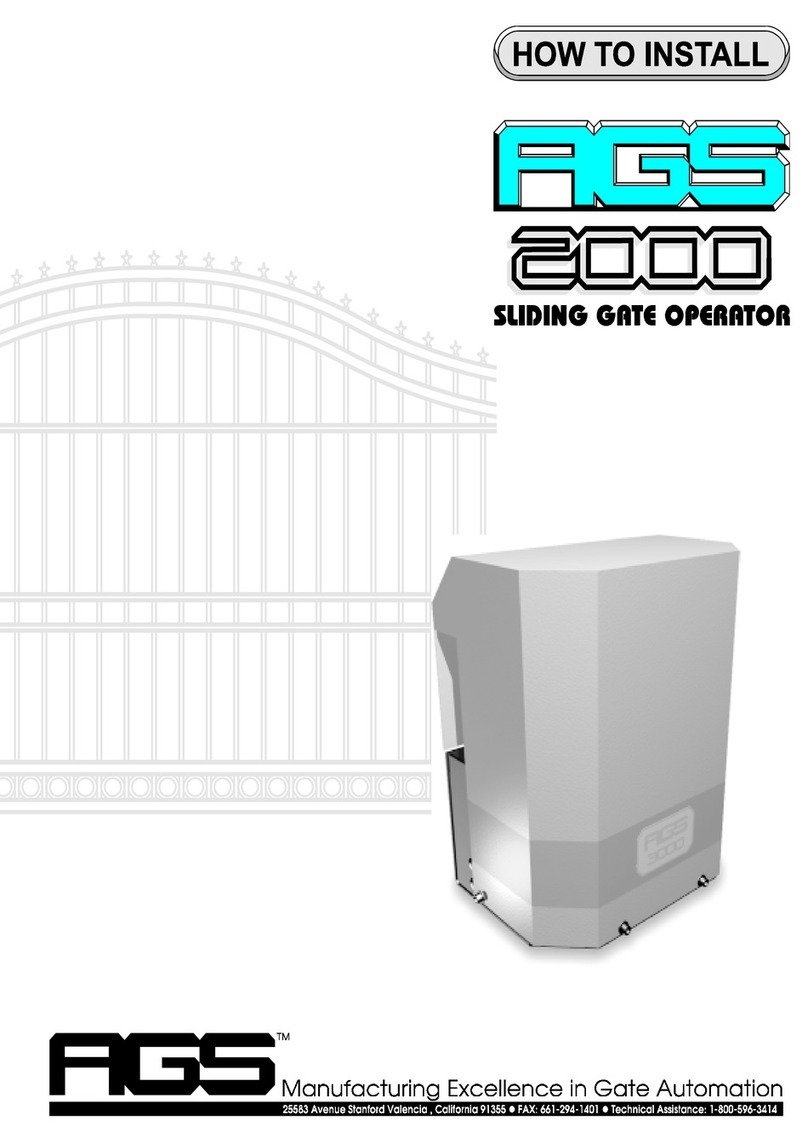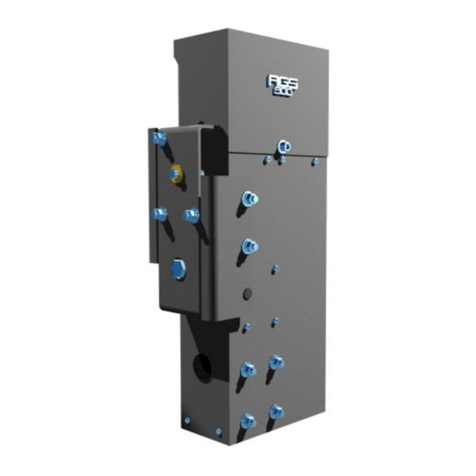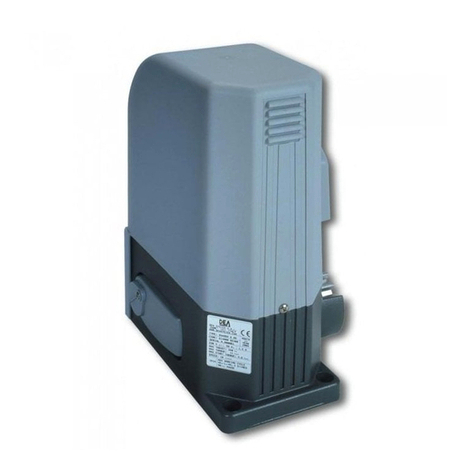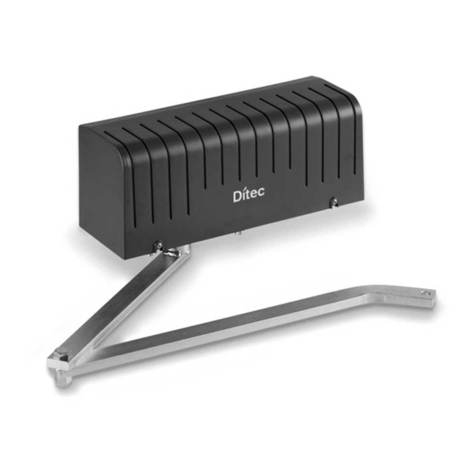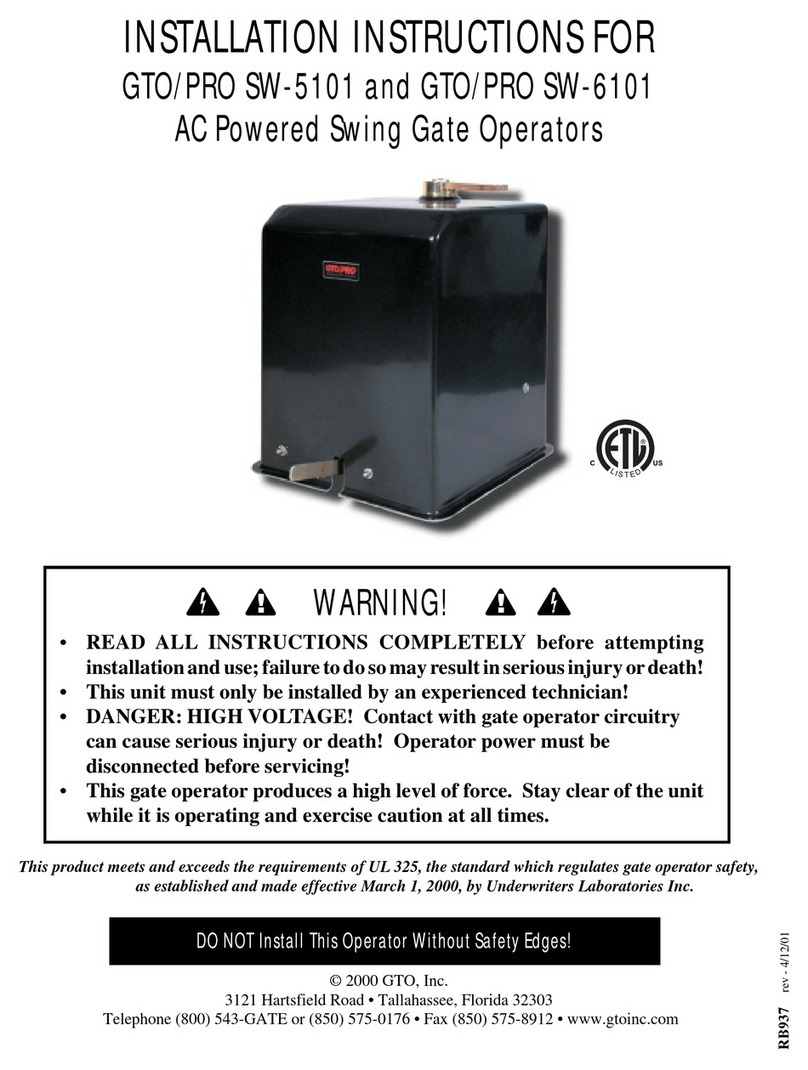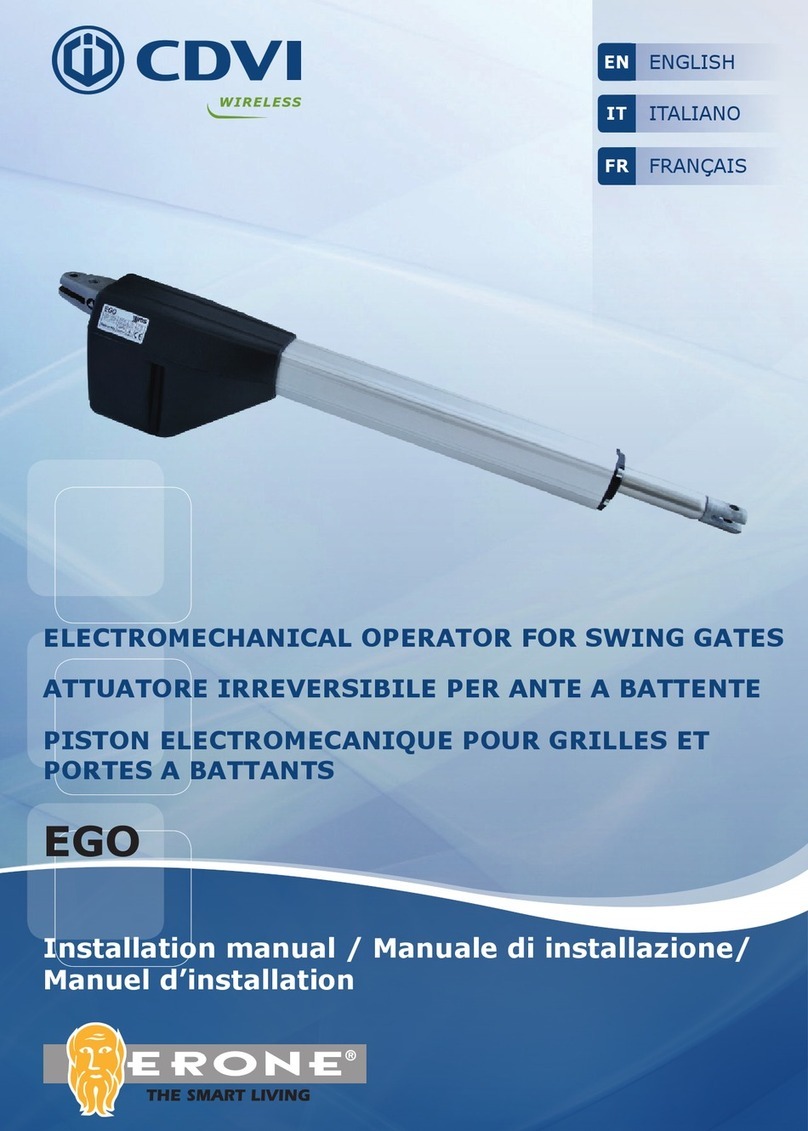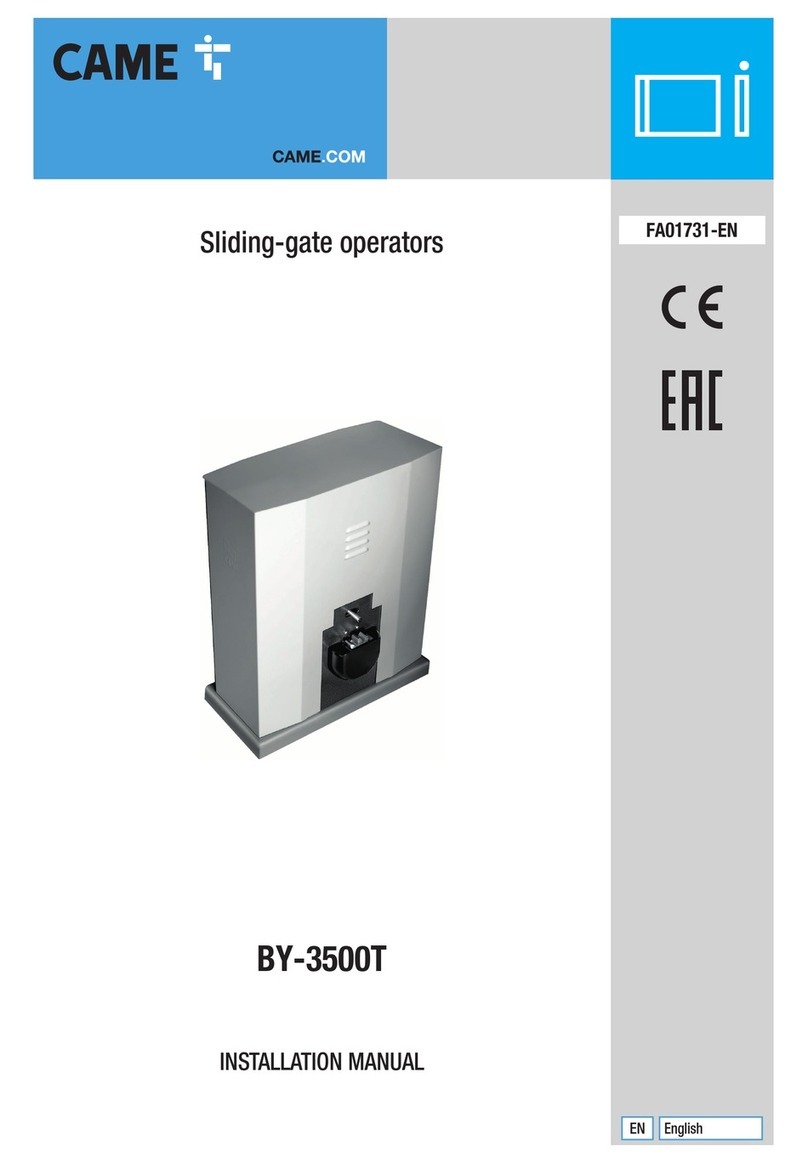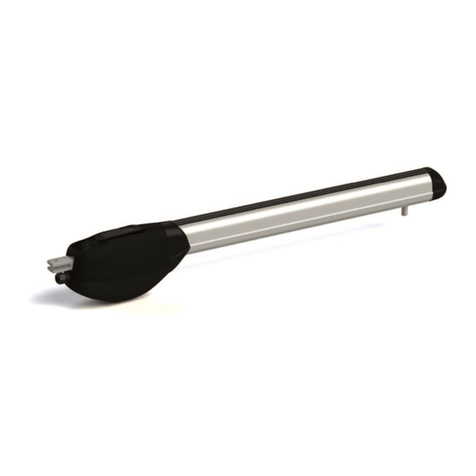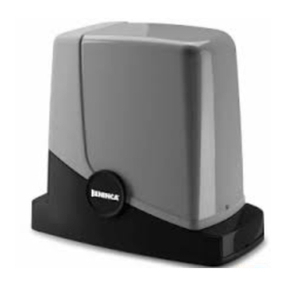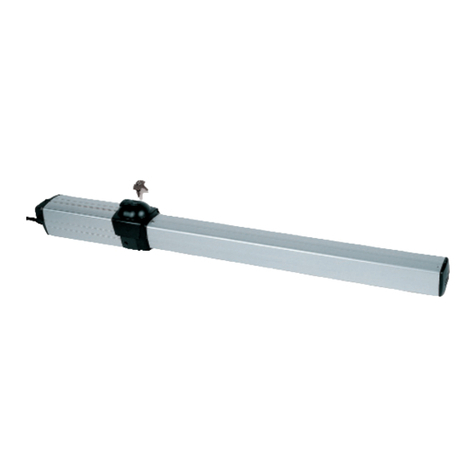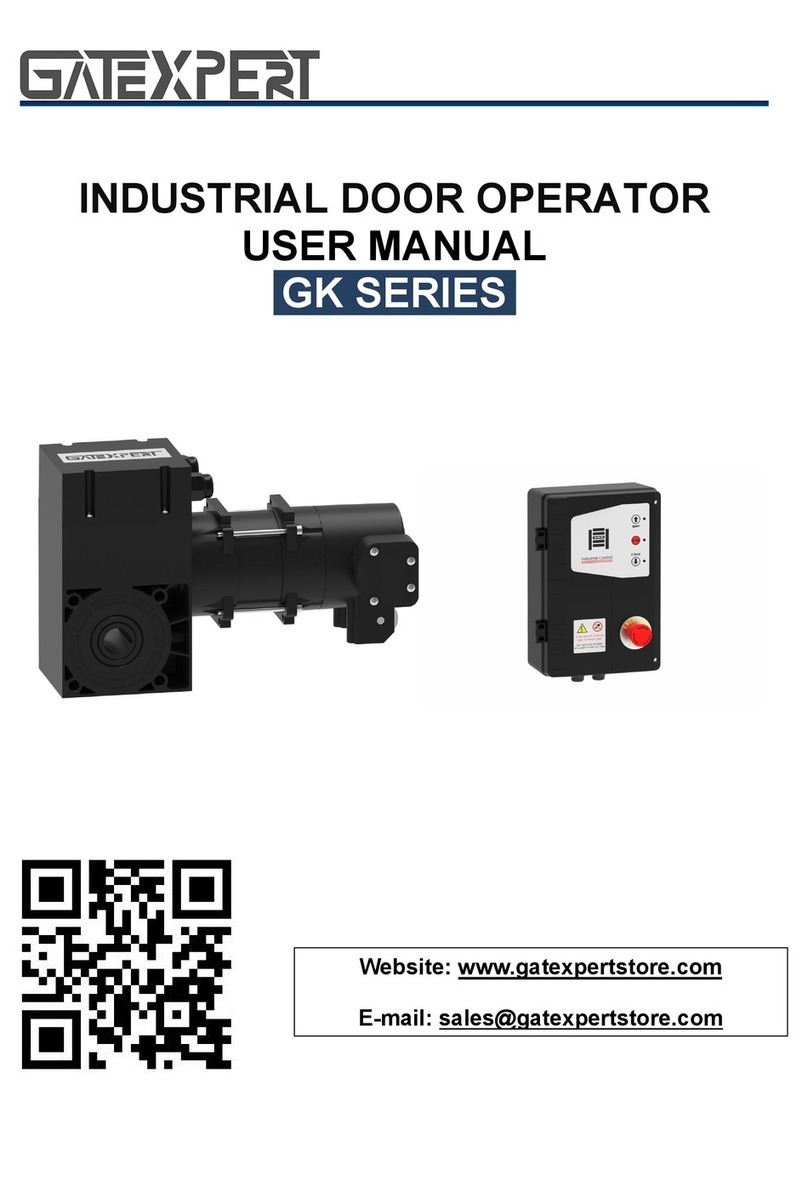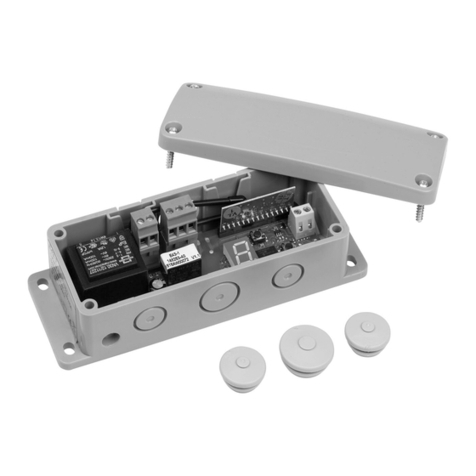AGS 105 Instruction sheet

pg 1

pg 2
General Information..............................................................................................................3-5
Features...................................................................................................................................6
Parts Identification................................................................................................................7-8
Installation...........................................................................................................................9-14
Electrical...........................................................................................................................15-16
Fine Tuning.......................................................................................................................17-18
Maintenance and Safety........................................................................................................19
Options.............................................................................................................................20-21
Pg.
Contents
Notes......................................................................................................................................28
Trouble Shooting..............................................................................................................25-27
Wiring Diagram......................................................................................................................24
Master/Slave..........................................................................................................................22
Reversing Edge.....................................................................................................................23
IMPORTANT INSTALLATION INSTRUCTIONS
WARNING-To reduce the risk of severe injury or death:
1) READ AND FOLLOW ALL INSTALLATION INSTRUCTIONS.
2) Make sure that the gate is properly installed. An improperly installed door could cause severe
injury. Have a qualified service person make repairs to the gate and other hardware before installing
the opener.
3) Do not connect the opener to source of power until unstructed to do so.
4) Locate the control button: (a) within sight of the door, (b) at a minimum hight of 5 feet so small
children cannot reach it, and (c) away from all moving parts of the door.

pg 3
mm
mm
mOVERALL DIMENSIONS: Height: 10 7/8"(28cm) Length: 23 5/8"(60cm) Width: 12 1/8"(31cm)
mm
mm
mSHIPPING WEIGHT: 110 pounds (50 kg)
mm
mm
mPOWER REQUIREMENT: Dedicated 115V (+/- 10V) AC, 10A Power Circuit
mm
mm
mAPPLICATIONS:
lMAXIMUM GATE WEIGHT: 500 pounds (227 kg)
lMAXIMUM GATE LENGTH: 15 feet (4.6 m)
mm
mm
mINCLUDED WITH OPERATOR:
Check package carefully and make sure it contains the following items.
1-Primary arm
2-Pipe sections 1/2" rigid (secondary arm)
1-Coupling 1/2" rigid
2-Swivel joints
1-Gate bracket
1-Caution sign
1-Allen wrench 5/16" (for cover)
1-Instructions manual
1-End fitting for 1/2" flexible conduit
4-Sleeve anchors 3/8"x3"
(See parts identification.)
General Informaton

pg 4
mm
mm
mOVERALL DIMENSIONS: Height: 12 1/2"(32cm) Length: 29 5/8"(75cm) Width: 15"(38cm)
mm
mm
mSHIPPING WEIGHT: 155 pounds (70 kg)
mm
mm
mPOWER REQUIREMENT: Dedicated 115V (+/- 10V) AC, 10A Power Circuit
mm
mm
mAPPLICATIONS:
lMAXIMUM GATE WEIGHT: 1000 pounds (454 kg)
lMAXIMUM GATE LENGTH: 22 feet (6.7 m)
mm
mm
mINCLUDED WITH OPERATOR:
Check package carefully and make sure it contains the following items.
1-Primary arm
2-Pipe sections 3/4" rigid (secondary arm)
1-Coupling 3/4" rigid
2-Swivel joints
1-Gate bracket
1-Caution sign
1-Allen wrench 5/16" (for cover)
1-Instructions manual
1-End fitting for 1/2" flexible conduit
4-Sleeve anchors 3/8"x3"
(See parts identification.)
General Information continued...

pg 5
mm
mm
mFUNCTION
The AGS 105 & 106 swinging gate operators are designed with a two piece rotational arm assembly that pulls the
swinging gate into the open position and pushes it back to the closed position. The arm assembly consists of a "primary
arm" which is attached at one end to the drive shaft on top of the operator and a "secondary arm" which is attached at one
end to the gate. The other ends of the primary arm and secondary arm are attached together with a swivel type joint. When
the primary arm rotates in the opening direction, the secondary arm follows it, pulling the gate open until the secondary arm
swings over the top of the primary arm. When the primary arm rotates in the closed direction, the secondary arm will again
follow it, pushing the gate closed until both arms are directly in line with one another. With botharms directly in line and the
gate in the closed position it is difficult to force the gate open.
mm
mm
mMANUAL RELEASE
The AGS 105 & 106, as a standard feature, have the ability to be opened manually in the case of a power failure.
When there is a power failure the gate can be easily opened by loosening the primary arm on the drive shaft with a single
wrench. Once this has been done, the primary arm will rotate freely on the drive shaft and will allow the gate to be pushed
open. If the gate needs to be released from the outside, there is an optional manual release arm (superARMTM) available
which can be adapted to both the AGS 105 & 106 to allow this added release capability. (See Options on page 21.)
mm
mm
mCIRCUIT BOARD
The AGS 105 & 106 gate operators are all equipped with Full Systems Capability circuit boards as a standard
feature. This circuit board operates on 24 Volts AC and delivers power directly to the motor without the use of external
switching. The limit switch input terminals require the use of normally open type limit switches. These switches are used to
accurately stop the gate operator in the open and closed positions. To safeguard the operator from damage that could
result from limit switch or sensitivity failure, the Full Systems Capability circuit board has a built-in maximum run timer
which will allow the operator to run for approximately 40 seconds and then shut off automatically. The Full Systems
Capability circuit board has an adjustable sensitivity feature which senses excess motor current if the gate or gate operator
is obstructed from free movement.
mm
mm
mSENSITIVITY
The Full Systems Capability circuit boards have a built in sensitivity feature which when adjusted properly will
deliver only enough power to the motor to overcome the resistance of the gate. The amount of power that the circuit board
will deliver can be adjusted for both directions of travel to accommodate the various gate weights that the AGS 105 and
AGS 106 operators are recommended for.
mm
mm
mMOTOR OUTPUT
The output to the motor is at plug 3 on terminals 17, 18 and 19. The input power for the motor is at this same plug
on terminals 15 and 16. The power that is delivered to the motor is 115 Volts AC. Terminal 16 is the AC NEUTRAL line in
and is connected internally to the motor center tap output terminal 18. Terminal 15 is the 115 Volts AC HOT line and is
switched internally by the circuit board triacs to either output terminal 17 for clockwise motor rotation or to output terminal
19 for counter-clockwise motor rotation. This output uses fully solid state triacs and requires no external relay switching to
deliver power to the motor.
mm
mm
mPERIPHERALS
POWER SUPPLY: There is 12 Volts DC or 24 Volts AC available on the circuit board which is used to supply power to a
radio receiver or other devices.
OPEN INPUT: Normally open devices are connected to terminals 1 and 2 at plug 2 on the circuit board to cause the gate to
open and/or close in PUSH-TO-OPEN/PUSH-TO-CLOSE (Timer switch OFF) mode of operation. Normally open devices are
connected to terminals 1 and 2 at plug 2 to cause the gate to open in AUTO CLOSE TIMER (Timer switch ON) mode of operation. In
this mode of operation the AUTO CLOSE TIMER will automatically close the gate after a specific amount of time has elapsed. These
normally open devices can be push buttons, radio receivers, key switches, loop detectors, photo electric beams, 24 hour timers, etc.
See FEATURES on the next page for other open input capabilities.
REVERSE INPUT: Normally open devices are connected to terminals 4 and 5 at plug 2 on the AGS 105 or 106 circuit
board to cause the gate operator to open and/or hold the gate open in any position except the fully closed position. Normally open
reverse input devices that can be used are push buttons, radio receivers, key switches, loop detectors, photo electric beams, 24 hour
timers, etc.
STOP INPUT: Normally closed devices are connected to terminals 6 and 7 at plug 2 after removing a jumper on the AGS
105 and 106 circuit board to cause the gate operator to stop in any position. This stop input can be used as a simple interrupt device
for pedestrian doors which may interfere with the gates operation and help prevent possible injury to a pedestrian. When the stop input
is used, the operator will stop and remain stopped until the stop circuit has been re-closed and until given an open input on terminals 1
and 2. Normally closed stop input devices that can be used are push buttons, key switches, loop detectors, photo electric beams, 24
hour timers, etc.
CLOSE INPUT: Normally open devices are connected to terminals 2 and 3 at plug 2 on the circuit board to cause the gate
operator to close the gate when in any position. Normally open input devices that can be used are push buttons, radio receivers, key
switches, loop detectors, photo electric beams, 24 hour timers, etc.
General Information continued...

pg 6
mm
mm
mOPERATION
The AGS 105 & 106 operators can operate in a AUTO CLOSE TIMER or a PUSH-TO-OPEN/PUSH-TO-CLOSE
mode of operation. In the AUTO CLOSE TIMER mode of operation the operator is given a command to open the gate and
hold it open until the input is released and/or until the auto close timer has elapsed at which point the operator will close the
gate automatically. In the PUSH-TO-OPEN/PUSH-TO-CLOSE mode of operation each time a signal is sent to the
operator, it will cause it to do the opposite of what it did before. (i.e., If the gate is closed, it will start opening, if it is open., it
will start closing: if it is closing, it will REVERSE TO OPEN, if it is opening, it will REVERSE TO CLOSE.)
mm
mm
mVISUAL FEEDBACK
The AGS 105 & 106 Full Systems Capability circuit board has been equipped with visual feedback LED's (small
indicator lights) to help simplify installation and troubleshooting. There are LED's located directly beside each input terminal
to indicate if any input devices are active. There are also two LED's which indicate that the circuit board is delivering power
to the motor and are labeled O and C for either the Opening or Closing directions of travel respectively. The newest feature
is the sensor LED's which are also labeled O and C to indicate if the internal sensing circuit has been triggered in either the
opening or closing directions of travel respectively. Collectively, all of the LED's combined provide quick glance information
to the installer or service technician showing visually what is happening in the normally invisible operation of the circuit
board.
mm
mm
mAUTO CLOSE TIMER
The operator comes factory preset with the auto close timer OFF. The auto close timer will close the gate
automatically after a specific amount of time has elapsed. The amount of time can be easily adjusted between 0 and 45
seconds by turning a small "pot" located on the left edge of the circuit board (See page 17). The timer can be disabled or
activated by flipping a single switch located on the top edge of the circuit board. If the timer will be used it is recommended
that some type of supplementary safety device be installed.
mm
mm
mSENSITIVITY ADJUSTMENT
The amount of force necessary to stop the gate can be adjusted to conform to the various sizes and weights of
any particular gate. When adjusting the sensitivity, the operator can be given only as much energy as is necessary to
overcome the resistance of the gate. If the gate should strike an obstruction in the closing direction, the gate will reverse to
the open position. If the gate should strike an obstruction in the opening direction, the gate will stop and remain stopped
until commanded to return to operation. (See page 17.)
mm
mm
mMASTER AND SLAVE
Some very large entrances may require the use of two gates. If this is the case, the two gates can be easily
automated using the "master and slave" configuration. This configuration uses two gates and two operators in ONE
driveway. The operators used are two regular AGS 105 or 106 operators. There is power run to each operator and
additionally there are six low voltage wires that are run from one operator to the other which cause them to operate
simultaneously. All controls such as radio transmitters are connected to only one operator (the "master").
mm
mm
mSHADOW INPUT
The AGS 105 and AGS 106 swing gate operators have a special shadow input feature which will give additional
safety to the swing gate operator system. Reverse loops are generally placed on both sides of a gate and as close as
possible to the gate to insure that the gate will never close while there is a vehicle present. Because of the nature of a
swinging gate, reverse loops have to be placed relatively far apart in order to prevent the gate from activating the loops.
The shadow input was designed to compensate for this limitation. This input will allow another loop to be placed directly in
the path of the gate in addition to the standard reverse loops. This input will only function while the gate is in the open
position and will hold the gate open while a vehicle is present. Because the input only functions while the gate is in the
open position, the gate will be allowed to pass over the loop and close, without the loop detector reversing the operator.
mm
mm
mPULSE OPEN INPUT
The Pulse Open input feature is an open input on the circuit board which will increase the security of the AGS 105
and 106 gate operator system. When an open input device such as a radio receiver is connected to the Pulse Open input,
and the radio transmitter is pressed, the gate operator will activate but will then ignore the input if the input is prolonged.
What is significant about this feature is that there is the possibility of a transmitter button being stuck and if the radio
receiver is connected to the standard open input the gate will be held open. If the radio receiver is connected to the Pulse
Open input on terminals 32 and 33 of plug 1, the circuit board will ignore the stuck input and will allow the gate to close.
The pulse open input is designed for but not limited to a radio receiver. For added security any open input device may be
used with Pulse Open including push buttons, key switches, numerical key pads etc.
Features

pg 7
Parts Identification

pg 8
PART # QNTY. QNTY.
501 1 BASE PLATE
502 1 BASE COVER (NOT SHOWN) 12 1/2" X 17 1/2"
503 1 MOTOR 1/2 HP
504 1 GEAR REDUCER SKK60
505 1 PULLY 1
506 1 PULLY 2
507 1 BELT 4L-200
508 4 BOLT STAINLESS 3/8-16 SOCKET CAP
509 4 WASHER STAINLESS 3/8 ID
510 4 BOLT 3/8-16 HEX HEAD
511 2 LIMIT CAM 1" BORE
512 1 LIMIT SWITCH PLATE
513 2 LIMIT SWITCH
514 2 SCREW 8-32 X 2"
515 2 SPACER
516 4 LOCKNUT 8-32
517 1 CONTROL BOX
518 1 CONTROL BOX COVER (NOT SHOWN)
519 2 SCREW 10-32
520 1 MOUNTING PLATE
521 1 CIRCUIT BOARD
522 1 PLEXI GLASS COVER
523 4 STANDOFF 1/2"
524 4 STANDOFF 1"
525 6 SCREW 8-32
526 4 SCREW 1/4-20 SOCKET CAP
527 1 TERMINAL BLOCK
528 4 SCREW 5/16 SOCKET CAP
529 2 SCREW 5/16 HEX HEAD
530 1 TRANSFORMER 24 VOLT
531
532
533
534
535
536
537
538
539
540
541
542
543
544
545
546
547
548
549
550
551
552
553
554
555
556
557
558
559
560
1 FLEXIBLE 1/2" LIQUIDTITE CONDUIT FITTING 90
1 FLEXIBLE 1/2" LIQUIDTITE CONDUIT FITTING END
1 RADIO RECEIVER 12 VDC
4 SLEAVE ANCHOR 3/8" X 3"
2 ACORN NUT 5/16 - 20
1 CLAMPING STUD 5/16 - 20
1 CLUTCHING CLAMP 1" BORE
1 OUTER PRIMARY ARM 23 1/2"
1 INNER PRIMARY ARM 20 1/2"
4 BOLT HEX HEAD 3/8-16
4 WASHER FLAT 3/8" ID
4 SPLIT WASHER 3/8" ID
4 NUT HEX 3/8-16
2 SWIVEL JOINT 7/8" ID
2 LARGE WASHER
2 LARGE SPLIT WASHER
2 NUT LARGE
2 1/2" RIGID PIPE (SECONDARY ARM)
1 COUPLING 1/2" RIGID
GATE BRACKET
1 CURRENT TRANSFORMER
1
PART # QNTY. QNTY.
601 1 BASE PLATE
602 1 BASE COVER (NOT SHOWN) 15 1/2" X 23 1/2"
603 1 MOTOR 1/2 HP
604 1 GEAR REDUCER SKK 80
605 1 PULLY 1
606 1 PULLY 2
607 1 BELT 4L-210
608 4 BOLT STAINLESS 3/8-16 SOCKET CAP
609 4 WASHER STAINLESS 3/8 ID
610 4 BOLT 3/8-16 HEX HEAD
611 2 LIMIT CAM 1 3/8" BORE
612 1 LIMIT SWITCH PLATE
613 2 LIMIT SWITCH
614 2 SCREW 8-32 X 2"
615 2 SPACER
616 4 LOCKNUT 8-32
617 1 CONTROL BOX
618 1 CONTROL BOX COVER (NOT SHOWN)
619 2 SCREW 10-32
620 1 MOUNTING PLATE
621 1 CIRCUIT BOARD
622 1 PLEXI GLASS COVER
623 4 STANDOFF 1/2"
624 4 STANDOFF 1"
625 6 SCREW 8-32
626 4 SCREW 1/4-20 SOCKET CAP
627 1 TERMINAL BLOCK
628 4 SCREW 5/16 SOCKET CAP
629 2 SCREW 5/16 HEX HEAD
630 1 TRANSFORMER 24 VOLT
631
632
633
634
635
636
637
638
639
640
641
642
643
644
645
646
647
648
649
650
651
652
653
654
655
656
657
658
659
660
1 FLEXIBLE 1/2" LIQUIDTITE CONDUIT FITTING 90
1 FLEXIBLE 1/2" LIQUIDTITE CONDUIT FITTING END
1 RADIO RECEIVER 12 VDC
4 SLEAVE ANCHOR 3/8" X 3"
2 ACORN NUT 3/8 - 16
1 CLAMPING STUD 3/8 - 16
1 CLUTCHING CLAMP 1 3/8" BORE
1 OUTER PRIMARY ARM 24"
1 INNER PRIMARY ARM 18 3/4"
4 BOLT HEX HEAD 3/8-16
4 WASHER FLAT 3/8" ID
4 SPLIT WASHER 3/8" ID
4 NUT HEX 3/8-16
2 SWIVEL JOINT 1" ID
2 LARGE WASHER
2 LARGE SPLIT WASHER
2 NUT LARGE
2 3/4" RIGID PIPE (SECONDARY ARM)
1 COUPLING 3/4" RIGID
GATE BRACKET
1 CURRENT TRANSFORMER
1
PART #
501
NOTE: USE THE LAST TWO NUMBERS TO LOCATE PARTS ON PAGE 7.
USE THE LAST TWO
Parts Identification continued...

pg 9
mRemove the gate operator from it's
package and make sure that all parts are
included. Refer to Parts Identification on pages 7
and 8.
mWith the gate in the closed position,
measure 3 FT from the center of the hinge
toward the gate opening and make a mark on
the gate.
mMake a mark on the ground just beneath
the mark that was made on the gate.
mSwing the gate into the open position
and make a second mark on the ground beneath
the mark that was made on the gate.
mTo determine the location of the gate
operator, draw a chalk line or an imaginary line
between the two marks that were made on the
ground and extend that line one or two feet
beyond the second mark. Place the operator so
that the drive shaft lies along the line.
mOnce the operator location is determined
you may pour a 2 FT wide by 3 FT long by 6"
deep concrete pad. You may also add 4" to the
height of the pad to give additional protection
from the elements, if necessary. (See steps 4
and 5 for general pad and operator location)
mSupply a 115V (+/- 10V) AC, 10 AMP
electrical circuit to the operator location.
ALTERNATIVE
mIf it is not convenient to use a concrete
pad to mount the operator, a steel mounting
stand may be used as an alternative. To position
the mounting stand, measure the location of the
operator shaft in relationship to the dirt stand or
refer to the illustrations on pages 3 and 4 and
mark the shaft location on the stand. Position the
stand as was done with the operator in step 2.
Dig two post holes and cement the stand in
place. Place a level on the stand and check it
periodically while the cement hardens. (The steel
mounting stand is available from AGS product
distributors.)
1
2
3
Installation

pg 10
mAlthough the gate operator can
be placed in virtually any position along
the imaginary line or rotated to face in
any direction, it is generaly positioned to
conserve as much space as possible.
The illustration at left shows a standard
location for the cement pad.
mThe pad size and location in the
illustration at left gives general dimen-
sions that will accomodate both the
AGS 105 and AGS 106 swing gate
operators. Because this pad size
applies to both gate operators it is not
the smallest pad that can be made.
mIf a smaller pad is preffered or if
the operator will be oriented differently
than shown, refer back to steps 2 and 3.
mOnce the cement pad has fully
hardened, place the operator onto the
pad and reposition the shaft so that it
lies along the imaginary line. If there is a
limited amount of space for the arm to
swing freely, place the operator edge
two inches from the edge of the gate
while it is in the open position. Remem-
ber, the shaft must lie along the imagi-
naryline.
mThe length of the secondary
arm will allow the operator to be placed
a maximum of 1 1/2 FT from the gate. If
it is nessecary to place the operator
further away, the supplied secondary
arm may be substituted with a length of
rigid conduit which can be obtained from
a local hardware store.
mThe gate operator is generally
positioned with the control box facing
toward the hinge, but can be oriented in
any direction as long as the shaft
remains along the imaginary line.
mWhen the gate operator location
and orientation have been determined,
drill through the four corner holes into
the cement pad. Use a 3/8" masonry
drill bit and drill at least 4" deep. Fasten
the operator to the cement pad using
the suppied 3/8" sleave anchors.
mIf the steel mounting stand was
used as an alternative to the cement
pad, simply place the operator onto
the stand and attach the operator
with four bolts and tighten firmly.
4
5
6

pg 11
mAttach one of the swivel
joints to the inner primary arm
using the flat washer on top of the
arm and the lock washer and nut
on the bottom. Tighten the nut
firmly.
mSlide the primary arm onto
the drive shaft and finger tighten
the acorn nuts.
mRotate the arm so that the
center of the arm is along the
imaginary line and so that the
swivel joint is aiming toward the
mark that was made on the gate.
mWhen the primary arm is
aiming toward the mark that was
made on the gate, tighten the arm
onto the drive shaft with a wrench.
mIf the AGS 105 is being
installed, the wrench used will be a
5/8" box/open end wrench or
socket. If the AGS 106 is being
installed, the wrench used will be a
3/4" box/open end wrench or
socket.
mWhen tightening the acorn
nuts, tighten both nuts evenly so
that same amount of threads are
being used on each end of the
stud. This will insure a tight
connection and will prevent
damage to the threads. DO NOT
over tighten the nuts.
7
8
9

pg 12
mAttach the remaining swivel
joint to the gate bracket using the flat
washer on top of the gate bracket and
the lock washer and nut on the bottom.
Tighten the nut firmly.
mWhen the remaining swivel
joint has been attached to the gate
bracket, place the gate bracket against
the gate above the mark that was
made on the gate so that the center of
the bracket is 3 FT from the center of
the gate hinge. If the gate is con-
structed with vertical pickets, try to
place the gate bracket so that it is in
contact with at least three pickets.
mTemporarily attach the gate
bracket to the gate with clamps.
mTo assemble the secondary
arm, connect the two rigid pipe sections
together using the rigid pipe coupling.
mMake sure that the rigid pipe
sections are turned as far as they will
go into the rigid coupling and tighten
firmly.
10
11
12

pg 13
mSlide one end of the second-
ary arm into the swivel joint that is
attached to the primary arm and the
other end into the swivel joint on the
gate bracket. Tighten the set screws
lightly on both of the swivel joints.
mPlace a level on top of the
secondary arm. If the arm is not level,
loosen the clamps holding the gate
bracket and move the gate bracket up
or down until the level indicates that
the arm is level. Retighten the clamps.
mThe gate bracket may now be
permanently attached to the gate. To
attach the bracket permanently, either
weld the bracket to the gate or drill
through the gate and gate bracket and
fasten with bolts.
mThe secondary arm is made
longer than neccesary to allow flexibil-
ity during installation and will need to
be cut to the correct length.
mTo find the length that the
secondary arm will need to be cut,
measurements will be taken in both
the open and closed positions.
mSwing the gate into the closed
position.
mMake sure that the arm is still
pointing directly at the swivel joint on
the gate bracket and that both swivel
joints are pointed toward each other.
mWith both swivel joints pointed
toward each other, measure the
distance between the inside edges of
the swivel joints.
mLoosen the acorn nuts on the
primary arm and swing the arm around
so that the gate can be opened.
mSwing the gate around so that
it is in the open position.
mRotate the primary arm so that
it is along the imaginary line and make
sure that the swivel joints are pointed
directly toward each other.
mWith both swivel joints pointed
toward each other measure the
distance between the inside edges of
the swivel joints.
mIf this measurement is differ-
ent from the first measurement, adjust
the inner primary arm in or out and
remeasure. Repeat this process until
both measurements are equal.
14
15
13

pg 14
mOnce the open and closed
measurements are the same from
steps 14 and 15, the length of the
secondary arm can be determined.
mThe length that the secondary
arm will be cut is found by taking the
equal distance that is found in steps
14 and 15 and then adding three
inches.
mWhen the length of the
secondary arm is determined, mea-
sure the secondary arm and make a
mark on the arm at the appropriate
length.
mSecure the secondary arm in
a vise and cut the arm on the mark.
mFirmly tighten the bolts that
fasten the inner primary arm to the
outer primary arm and swing the arm
toward the gate bracket.
mSlide one end of the second-
ary arm into the swivel joint on the
primary arm and the other end into the
swivel joint on the gate bracket.
mWith the secondary arm
inserted into the swivel joint on the
primary arm, firmly tighten the set
screws in the swivel joint.
mMake sure that the gate is still
able to be placed in the correct closed
position and firmly tighten the set
screws in the swivel joint that is on the
gate bracket.
16
17
18

pg 15
mCAUTION: Before making any electrical
connections, make sure that the power is OFF.
mThe AGS 105 and AGS 106 swing gate
operators are supplied with fittings for 1/2"
Liquidtite flexible conduit. If another type of
electrical conduit will be used, the installer must
provide fittings for that type of conduit.
mRun a length of 1/2" flexible conduit from
the junction box into the operator control box
using the supplied flexible conduit fittings. If
there is not a 115 Volt power source at or near
the location of the operator, have an electician
install one.
mRun three 12 gauge wires through the
flexible conduit from the junction box to the
operator control box. The three wires should be
black, white and green respectively.
mConnect the black (HOT) wire to the top
screw terminal on the high voltage terminal block
inside of the operator control box.
mConnect the white (NEUTRAL) wire to
the second from the top screw terminal on the
high voltage terminal block inside of the control
box.
mConnect the green (GROUND) wire to
the bottom screw terminal on the high voltage
terminal block inside of the control box. Make
sure that the other end of the green (GROUND)
wire is connected to a good earth ground. This
will help protect the gate operator from voltage
spikes and lightning.
mWhen the power wires have been
connected, the gate operator may now be
energized by turning on the main breaker switch.
Run the gate operator a few times with the
primary arm disconnected to make sure the
system is functioning properly.
mIf radio controls are being used to
activate the gate operator, it is advisable to
change the code inside of both the transmitter
and the receiver. This can very easily be done by
the installer or the home owner and will decrease
the possibility of duplicating the code. Inside of
both the transmitter and receiver is a switch
block with a row of small switches. First open the
receiver and set the switches to any desired
position. Next, open the transmitter and set the
switches to match the switches that are inside of
the receiver. Close both the transmitter and
receiver. The code is now set and ready for
operation.
Electrical
1
2
3

pg 16
Electrical continued...
mREVERSE INPUT: Any device that is used to
open and/or hold open the gate while the gate is in a non-
closed position is a reverse input device. The reverse input
device must provide normally open contacts. These
contacts are connected to plug 2 on terminals 4 and 5.
This function is especially useful when the auto close timer
is being used in preventing the gate from accidentally
closing on a pedestrian or vehicle.
mSHADOW INPUT: Any device that is used to hold
open the gate only when the gate is in the open position is
a shadow input device. The shadow input device must
provide normally open contacts. These contacts are
connected to plug 2 on terminals 7 and 8. This function is
very useful for swinging gate operators with loop detectors
installed when it is necessary to put a vehicle loop in a
location where the gate will swing over it. This input will
allow the gate to pass over the loop without the loop
detector reversing the gate operator.
mPULSE OPEN INPUT: The pulse open input
terminals were put on the circuit board as an alternative
connection for the radio receiver. This input functions
similarly to the standard open input with the exception that
it will not hold the gate open if the input remains present.
This feature will add additional security to the gate operator
system in the event that there is a transmitter that is stuck
on.
mOPEN INPUT: Any device that is used to open the
gate from a closed position is an open input device. The
device used must provide normally open contacts. These
normally open contacts are connected to plug 2 on terminals 1
and 2. These open input terminals will cause the gate operator
to open and/or close if the timer switch is in the OFF position
(Push-To-Open/Push-To-Close mode). If the timer switch is in
the ON position (Auto Close Timer mode), these open input
terminals will cause the gate operator to open and will hold the
gate open until the input is released and the auto close time
has elapsed.
mCLOSE INPUT: Any device that is used to close the
gate is a close input device. The device used must provide
normally open contacts. These normally open contacts are
connected to plug 2 on terminals 2 and 3. These close input
terminals will cause the gate operator to close the gate any
time the gate is in a non-closed position and can be used to
override the timer and close the gate prematurely.
mSTOP INPUT: Any device that is used to stop the
gate operator while it is running in the open or closed direction
is a stop input device. These stop input devices must provide
normally closed contacts. To connect these normally closed
contacts, remove the stop jumper from terminals 6 and 7 and
then connect the contacts to these same terminals 6 and 7.
4CONNECTIONS
TO AVOID POSSIBLE INJURY OR
DAMAGE TO EQUIPMENT
DO NOT MAKE ELECTRICAL
CONNECTIONS WHILE POWER
IS ON

pg 17
lIf auto close timer is used,
move the AUTO CLOSE TIMER
switch to the ON position.
lTo set the auto close time to a
desired length between 0-45
seconds, turn the timer adjust-
ment "pot" clockwise to increase
the amount of time and counter-
clockwise to decrease.
lThe LEFT/RIGHT SIDE OP-
ERATION switch must be set in
the right or left position depending
on which side of the driveway the
gate operator is located. The right
or left handing of the operator is
determined in reference to the
inside of the driveway looking out.
(See page 18.)
lWhen the operator installation
is complete, adjust the amount of
force needed to reverse the gate
in both the opening and closing
directions. This is done by turning
the "sensitivity adjustment pots"
CLOCKWISE for more sensitivity,
and COUNTER-CLOCKWISE for
less sensitivity.
1
2
Fine Tuning

pg 18
RIGHT SIDE OPERATION
LEFT SIDE OPERATION
3
4
mIn order for the gate
operator to function properly the
Right/Left Side operation switch
must be set correctly. (See page
17 for Right/Left Side switch
setting.)
mThe illustration at left
shows the difference between a
right and left side installation.
mAn easy way to deter-
mine if the Right/Left switch is
set correctly is to run the gate
operator and observe the
rotation of the shaft. If an input
is given to open the gate opera-
tor on terminals 1 and 2, the
operator shaft will rotate in the
same direction that the gate
rotates when it opens. If the
operator is given an input to
close on terminals 2 and 3 the
shaft should rotate in the same
direction that gate rotates when
it is closing. If the gate rotates
clockwise to open then the drive
shaft should rotate clockwise
when an open input is given on
terminals 1 and 2. If the gate
rotates counter-clockwise to
close, then the drive shaft
should rotate counter-clockwise
when a close input is given on
terminals 2 and 3.
mAdjust the limits of travel
on the gate operator to make
the gate stop in the correct open
and closed positions.
mWith the arm loose or
disconnected give the operator
an input to close on terminals 2
and 3.
mSwing the gate into the
closed position, rotate the
primary arm so that it is in line
with the secondary arm and
tighten the acorn nuts on the
primary arm firmly.
mGive the operator an
open input on terminals 1 and 2.
If the gate does not completely
open before the limit cam is
engaged with the open limit
switch, rotate the limit cam to
increase the distance of travel.
Repeat this process until the
gate stops in the correct open
and closed positions.
Fine Tuning continued...

pg 19
mm
mm
mSENSITIVITY ADJUSTMENTS
The most important thing to maintain on any gate is the safety equipment. As the gate becomes
older, the amount of force necessary to move the gate will vary. When this happens, the sensitivity
adjustments may need to be readjusted. Check to see whether the sensitivity may need adjustment at
least once a month. Actuate the gate a few times and observe the amount of force that is needed to
reverse the gate in both directions. The gate should reverse relatively easy. If it does not reverse easily or
does not reverse at all, make adjustments as done in step 2 of Fine Tuning.
mm
mm
mCONTROL DEVICES
From time to time check to see whether all of the control devices that are connected to the
operator are functioning. This is especially important of interupt devices such as reverse loops, reverse
edges, photo beams, or any other device which was installed in regards to safety.
mm
mm
mGATE
Having a well maintained gate will ensure that the operator runs smoothly and safely.
Occasionally inspect the gate to see that it swings easily and free of any obstructions. See if the hinges
show any sign of rusting and grease or oil if necessary.
TheAGS105and106aredesignedtobeMAINTENANCEFREE.
However, for optimum performance and safety, the following
maintenance procedures should be taken.
Maintenance and Safety
mm
mm
mCHILDREN
DO NOT allow children to operate the gate or play with the gate operator.
DO NOT allow children to play in the gate area.
mm
mm
mVISIBILITY
DO NOT activate the gate from a location where you cannot see the gate.
There may be children playing in the gate area or someone who will not be able to
move away from the gate in time.
IMPORTANT INSTALLATION INSTRUCTIONS
WARNING-To reduce the risk of severe injury or death:
1) READ AND FOLLOW ALL INSTALLATION INSTRUCTIONS.
2) Never let children operate or play with door controls. Keep the remote control away from children.
3) Always keep the moving door in sight and away from people and objects until it is completely
closed. NO ONE SHOULD CROSS THE PATH OF THE MOVING DOOR.
4) SAVE THESE INSTRUCTIONS.

pg 20
AUXILLIARY INDICATOR LIGHT mThe control board has a special
terminal that is specifically for connect-
ing an auxiliary light which can be
placed typically inside of the residence
or building to indicate if the gate is in
motion (opening or closing).
mIt is recommended that an LED
(Light Emitting Diode) be used as the
auxiliary light and that a 1000 ohm
resistor be connected in series with the
LED as shown at left.
mConnect the negative lead of
the LED to terminal 25. The positive
lead of the LED may be connected to
terminal 26 for 12 Volt DC or to terminal
30 for 24 Volt AC.
mWhat is a loop?: A loop is a
device that is placed in the driveway
and is used to detect the presence of a
vehicle. This device consists of a coil of
wire (loop) which is placed in the
driveway and a loop detector which is
placed in or near the gate operator. The
loop is connected to the loop detector
and the loop detector is connected to
the gate operator circuit board to
perform any of the gate operator
functions including open, reverse, stop
etc. One loop detector is used to
perform each specific function.
mHow does a loop work?: A loop
creates a magnetic field in the driveway
which is sensitive to the presence of
metal. When a metal object such as a
vehicle approaches the loop, the loop
detector senses a change in the
magnetic field and sends the message
to the gate operator.
mReverse Loop: If the gate is
closing and there is a car driving
through the entrance, the gate will
reverse when the car passes over the
reverse loop. If the car remains on the
loop, the gate will be held open.
mOpen Loop: This is a "Free
Exit" loop which will cause the gate to
open from any position when a car
passes over it.
mShadow Loop: This is a "Hold
Open" loop which works only when the
gate is already open and will not
reverse the gate.
REVERSE AND OPEN LOOPS
Options
1
2
NOTE: If the loop option will be installed, see the How To Install
Open and Reverse Loops manual published by AGS.
(Options continued on next page.)
This manual suits for next models
1
Table of contents
Other AGS Gate Opener manuals
Popular Gate Opener manuals by other brands
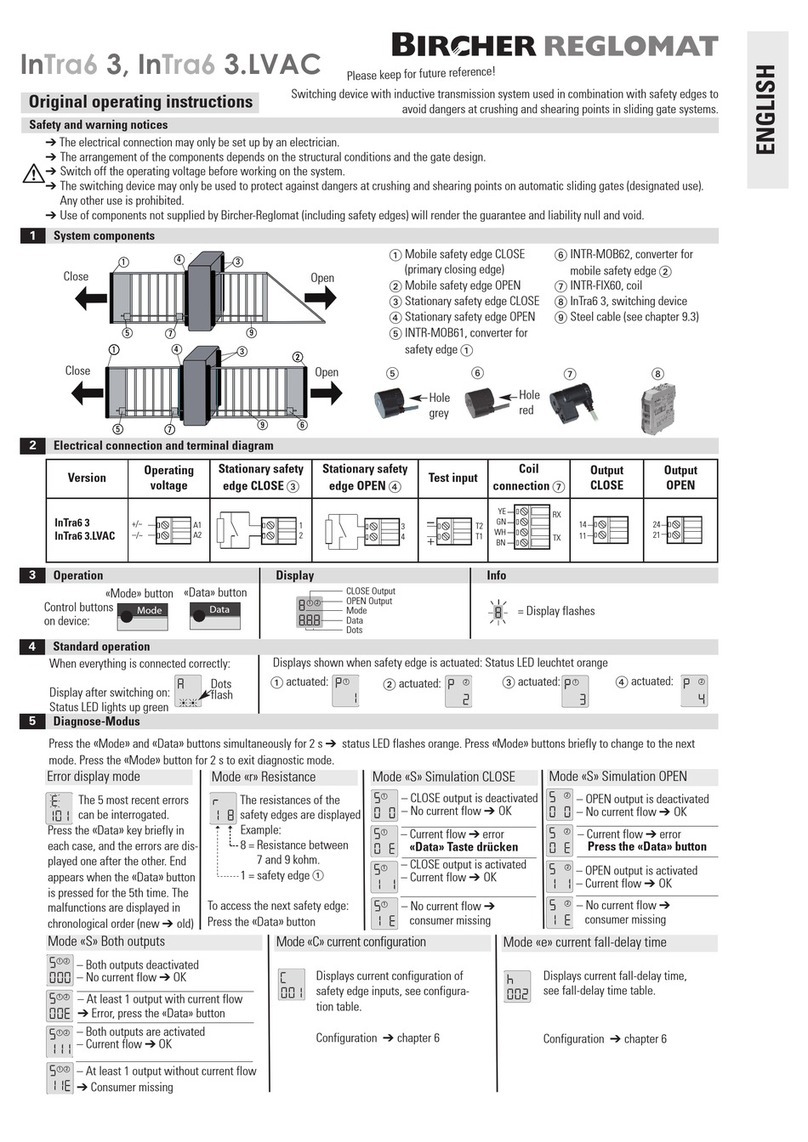
Bircher Reglomat
Bircher Reglomat InTra6 3 operating instructions
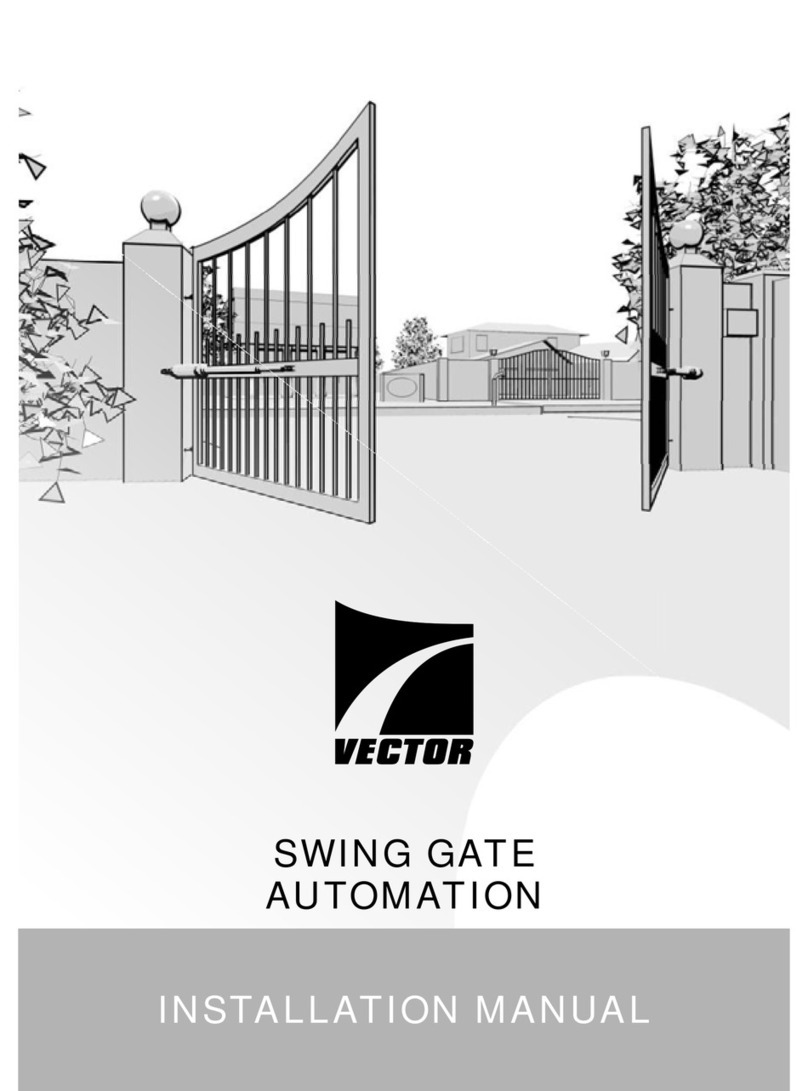
Vector
Vector V400 installation manual

Riello Elettronica
Riello Elettronica Cardin BL Series instruction manual
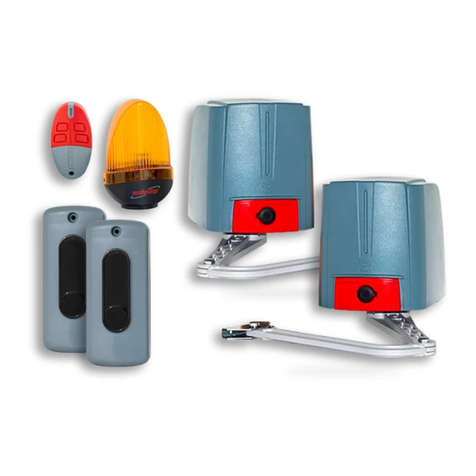
Motostar
Motostar ECLISTAR installation manual
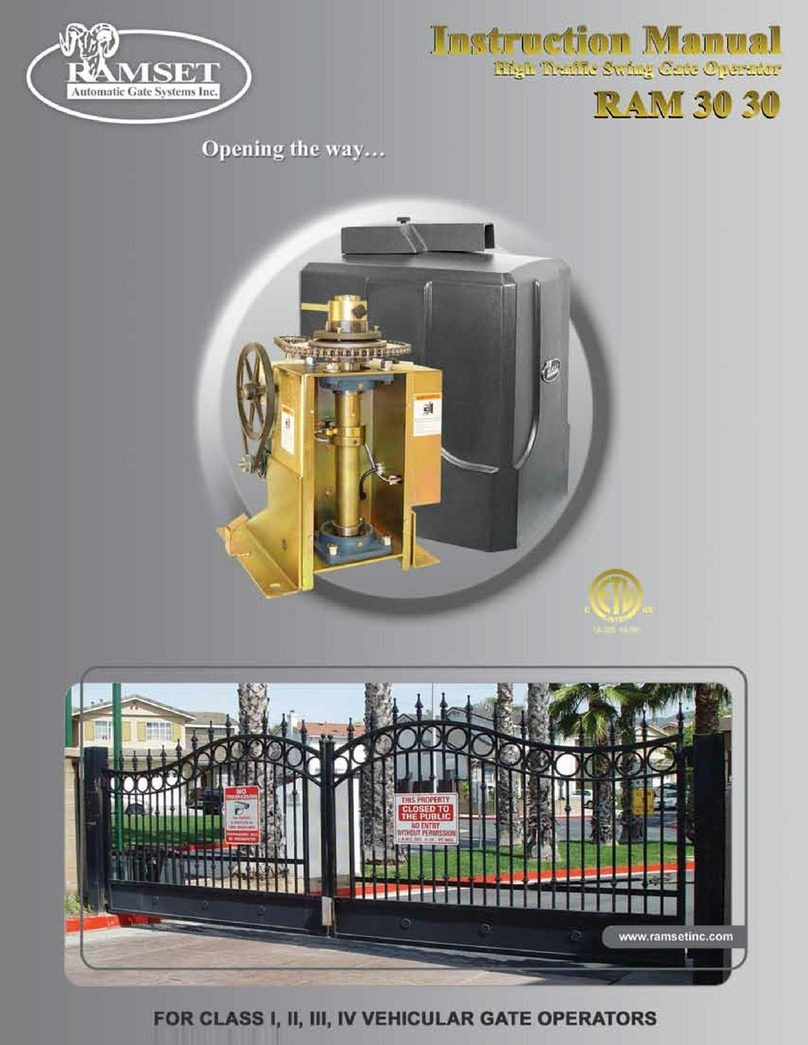
RAMSET
RAMSET RAM 30 30 instruction manual

Maximum Controls
Maximum Controls Max Phantom 2000 Installation and owner's manual

